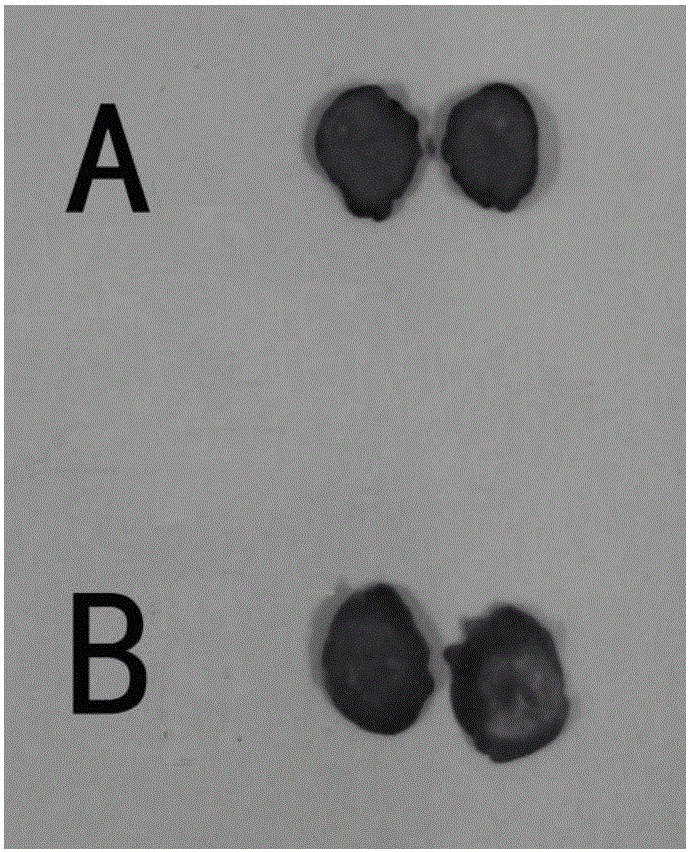Method for detecting cell viability of fresh Cordyceps sinensis
A technology for fresh Cordyceps sinensis and Cordyceps sinensis, which is applied in the field of agricultural product detection, can solve the problems of poor repeatability and stability of Cordyceps sinensis cell viability detection, inability to accurately and truly reflect Cordyceps sinensis cell viability, low sensitivity, etc., and achieves shortened dyeing time, low cost, and low sensitivity. The effect of increasing sensitivity
- Summary
- Abstract
- Description
- Claims
- Application Information
AI Technical Summary
Problems solved by technology
Method used
Image
Examples
Embodiment 1
[0031] (1) Take fresh Cordyceps sinensis out of the storage environment, and carry out pretreatment. The method is: place it in a 5% glucose solution preheated to 37°C and immerse it in a 37°C water bath for 15 minutes;
[0032] (2) slice the fresh Cordyceps sinensis worm body part treated in step (1), and the slicing part is the 4th to 7th pair of foot sections of the worm body, cut into 1-2mm thin slices, and cut 10 pieces;
[0033] (3) Place fresh Cordyceps sinensis slices in a small beaker equipped with 0.3% TTC solution for soaking, and place them in a water bath at 37° C. for dark dyeing;
[0034] (4) When the dyeing time is 0.5 hour, 1 hour, 2 hours, 4 hours, and 8 hours, take out 2 slices of fresh Cordyceps sinensis after dyeing, blot the surface moisture, observe the color, and take pictures.
[0035] The result is as figure 2 As shown, it can be seen from the results that after five different dyeing times, after 0.5 hours of dyeing, the Cordyceps slices began to be...
Embodiment 2
[0037] (1) Take 2 fresh Cordyceps sinensis out of the storage environment, and carry out pretreatment on one, the method is: place it in 5% glucose solution preheated to 37 ℃, immerse in 37 ℃ water bath for 15 minutes; do not pretreat the other one, directly ready for use;
[0038] (2) Slice the same parts of the fresh Cordyceps sinensis treated in step (1) and the Cordyceps sinensis without pretreatment, and the sliced parts are the 4-7 pairs of legs of the insect body, cut into 1-2mm thin slices, each Cut the roots into 4 slices;
[0039] (3) Place 2 slices of fresh Cordyceps sinensis in small beakers filled with TTC solution with a mass fraction of 0.3% for soaking, and place them in a water bath at 37° C. for dark dyeing;
[0040] (4) Take out 2 sections of fresh Cordyceps sinensis when the dyeing time is 2 hours, blot the surface moisture, observe the color, and take pictures.
[0041] The result is as image 3As shown, it can be seen from the results that the color ...
Embodiment 3
[0043] (1) Take fresh Cordyceps sinensis out of the storage environment, and carry out pretreatment. The method is: place it in a 5% glucose solution preheated to 37°C and immerse it in a 37°C water bath for 15 minutes;
[0044] (2) The fresh Cordyceps sinensis processed in step (1) is divided into 4 sections and sliced, which are respectively the Cordyceps sinensis section, the worm body head to the 4th pair of feet section, the 4th-7 pair of feet section and From the seventh pair of feet to the tail, take 4 pieces from each of the 4 sections, and cut each piece into 1-2 mm thin slices;
[0045] (3) The fresh Cordyceps sinensis slices of 4 different sections were respectively placed in a small beaker with a mass fraction of 0.3% TTC solution for soaking, and placed in a 37°C water bath for dark dyeing;
[0046] (4) Take out the slices of fresh Cordyceps sinensis after 2 hours of dyeing, blot the surface moisture, observe the color, and take pictures.
[0047] The result is a...
PUM
| Property | Measurement | Unit |
|---|---|---|
| thickness | aaaaa | aaaaa |
Abstract
Description
Claims
Application Information
 Login to View More
Login to View More - R&D
- Intellectual Property
- Life Sciences
- Materials
- Tech Scout
- Unparalleled Data Quality
- Higher Quality Content
- 60% Fewer Hallucinations
Browse by: Latest US Patents, China's latest patents, Technical Efficacy Thesaurus, Application Domain, Technology Topic, Popular Technical Reports.
© 2025 PatSnap. All rights reserved.Legal|Privacy policy|Modern Slavery Act Transparency Statement|Sitemap|About US| Contact US: help@patsnap.com



